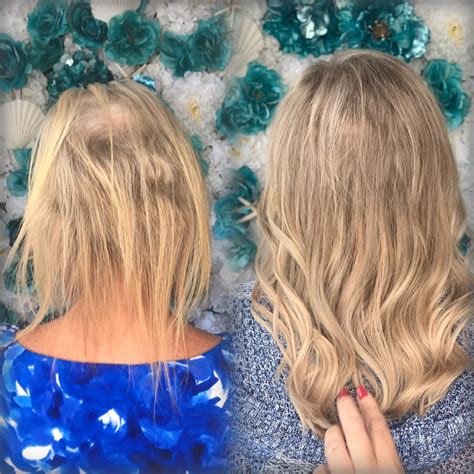Understanding Fine Hair
Fine hair is characterized by its thin strands and lack of volume. According to the American Academy of Dermatology, approximately 50% of the population has fine hair. This type of hair requires specific care and styling techniques to enhance its appearance.

Types of Hair Extensions for Fine Hair
There are various types of hair extensions available, but not all are suitable for fine hair. Here are the six best extensions specifically designed for fine hair:
1. Clip-In Extensions
- Temporary extensions that clip in and out of hair
- Ideal for adding volume and length
- Can be used to create different styles
2. Tape-In Extensions
- Semi-permanent extensions that attach with adhesive tape
- Provides a natural and discreet look
- Can last for up to 8 weeks
3. Micro-Link Extensions
- Small, beaded extensions that are attached with pliers
- Creates a secure and long-lasting bond
- Can damage hair if not applied correctly
4. Fusion Extensions
- Permanent extensions that use heat to fuse the extensions to the natural hair
- Provides maximum volume and length
- Requires professional installation and maintenance
5. Halo Extensions
- Hidden wire that wraps around the head
- Attaches the extensions to the crown of the hair
- Creates instant volume without clips or tapes
6. Ponytail Extensions
- Clip-on or tie-on extensions that create a full and voluminous ponytail
- Ideal for special occasions or quick hairstyles
Choosing the Best Extensions for Fine Hair
When selecting hair extensions for fine hair, consider the following factors:
- Hair Type: Choose extensions that match your natural hair texture.
- Hair Color: Opt for extensions that closely resemble your own hair color.
- Hair Length: Determine the desired length of extensions to achieve the look you want.
- Maintenance: Consider the time and effort required to maintain the extensions.
- Budget: Hair extensions can range in price, so set a budget before making a purchase.
Pros and Cons of Different Extensions
| Extension Type | Pros | Cons |
|---|---|---|
| Clip-In | Easy to apply and remove | Can slip out with excessive movement |
| Tape-In | Discreet and natural | Requires professional installation |
| Micro-Link | Secure and long-lasting | Can be damaging to hair |
| Fusion | Maximum volume and length | Permanent and requires professional maintenance |
| Halo | Instant volume | Can be uncomfortable to wear for extended periods |
| Ponytail | Versatility | May not blend seamlessly with natural hair |
How to Apply Hair Extensions for Fine Hair
For best results, it is recommended to have hair extensions applied by a professional stylist. However, here are step-by-step instructions for applying clip-in extensions:
- Brush your hair to remove tangles.
- Divide your hair into horizontal layers.
- Clip the extensions onto the bottom layer, close to the roots.
- Work your way up the layers, adding extensions as needed.
- Style your hair as desired.
Maintenance Tips for Hair Extensions
To prolong the lifespan of your hair extensions, follow these maintenance tips:
- Wash extensions gently with sulfate-free shampoo.
- Use a wide-toothed comb or brush to avoid breakage.
- Avoid using heat styling tools on high settings.
- Store extensions in a cool, dry place when not in use.
- Get regular trims to remove split ends.
Frequently Asked Questions
1. Can I use any type of extensions on fine hair?
No, some extensions, such as micro-links and fusion, can be too heavy for fine hair.
2. How long can I wear hair extensions?
The lifespan of hair extensions varies depending on the type and maintenance. Clip-in extensions can last for a few months, while tape-in and fusion extensions can last for several weeks to months.
3. Will hair extensions damage my natural hair?
If applied improperly, hair extensions can cause damage to fine hair. It is crucial to have them applied by a professional stylist.
4. Are hair extensions expensive?
The cost of hair extensions varies depending on the type, length, and quality. However, they can range from a few hundred to several thousand dollars.
5. How often should I get my hair extensions maintained?
The frequency of maintenance depends on the type of extensions and your hair growth rate. Generally, clip-in extensions require monthly maintenance, while tape-in and fusion extensions require more frequent visits.
6. Can I dye my hair extensions?
Most hair extensions can be dyed, but it is recommended to have it done by a professional to avoid damage.
Creative Applications for Hair Extensions
Beyond adding volume and length, hair extensions can also be used for creative styling applications:
- Ombre Effect: Use extensions with different shades to create a gradual color transition.
- Balayage Highlights: Add subtle highlights to your hair using extensions.
- Color Correction: Cover up unwanted hair colors or create vibrant shades.
- Double Helix Braid: Style extensions into a unique and eye-catching braid.
- Boho Crown: Braid extensions into a whimsical headband or crown.
Conclusion
Hair extensions can transform fine hair, providing volume, length, and style options. By choosing the right type of extensions and following proper maintenance techniques, you can enjoy beautiful, fuller-looking hair. Remember to consult with a professional stylist for expert advice and the best results.
